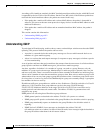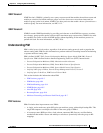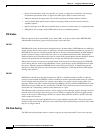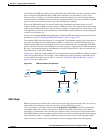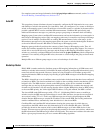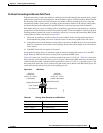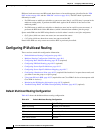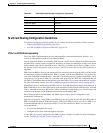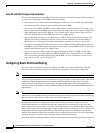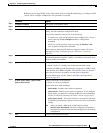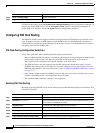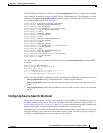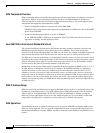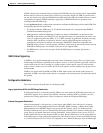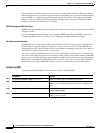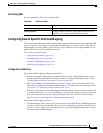
40-10
Cisco ME 3400 Ethernet Access Switch Software Configuration Guide
OL-9639-06
Chapter 40 Configuring IP Multicast Routing
Configuring IP Multicast Routing
Auto-RP and BSR Configuration Guidelines
There are two approaches to using PIMv2. You can use Version 2 exclusively in your network or migrate
to Version 2 by employing a mixed PIM version environment.
• If your network is all Cisco routers and multilayer switches, you can use either Auto-RP or BSR.
• If you have non-Cisco routers in your network, you must use BSR.
• If you have Cisco PIMv1 and PIMv2 routers and multilayer switches and non-Cisco routers, you
must use both Auto-RP and BSR. If your network includes routers from other vendors, configure the
Auto-RP mapping agent and the BSR on a Cisco PIMv2 device. Ensure that no PIMv1 device is
located in the path a between the BSR and a non-Cisco PIMv2 device.
• Because bootstrap messages are sent hop-by-hop, a PIMv1 device prevents these messages from
reaching all routers and multilayer switches in your network. Therefore, if your network has a
PIMv1 device in it and only Cisco routers and multilayer switches, it is best to use Auto-RP.
• If you have a network that includes non-Cisco routers, configure the Auto-RP mapping agent and
the BSR on a Cisco PIMv2 router or multilayer switch. Ensure that no PIMv1 device is on the path
between the BSR and a non-Cisco PIMv2 router.
• If you have non-Cisco PIMv2 routers that need to interoperate with Cisco PIMv1 routers and
multilayer switches, both Auto-RP and a BSR are required. We recommend that a Cisco PIMv2
device be both the Auto-RP mapping agent and the BSR. For more information, see the
“Using
Auto-RP and a BSR” section on page 40-32.
Configuring Basic Multicast Routing
You must enable IP multicast routing and configure the PIM version and the PIM mode. Then the
software can forward multicast packets, and the switch can populate its multicast routing table.
Note To enable IP multicast routing, the switch must be running the metro IP access image.
You can configure an interface to be in PIM dense mode, sparse mode, or sparse-dense mode. The switch
populates its multicast routing table and forwards multicast packets it receives from its directly
connected LANs according to the mode setting. You must enable PIM in one of these modes for an
interface to perform IP multicast routing. Enabling PIM on an interface also enables IGMP operation on
that interface.
Note If you enable PIM on multiple interfaces and most of these interfaces are not part of the outgoing
interface list, when IGMP snooping is disabled the outgoing interface might not be able to sustain line
rate for multicast traffic because of the extra, unnecessary replication.
In populating the multicast routing table, dense-mode interfaces are always added to the table.
Sparse-mode interfaces are added to the table only when periodic join messages are received from
downstream devices or when there is a directly connected member on the interface. When forwarding
from a LAN, sparse-mode operation occurs if there is an RP known for the group. If so, the packets are
encapsulated and sent toward the RP. When no RP is known, the packet is flooded in a dense-mode
fashion. If the multicast traffic from a specific source is sufficient, the receiver’s first-hop router might
send join messages toward the source to build a source-based distribution tree.
By default, multicast routing is disabled, and there is no default mode setting. This procedure is required.



